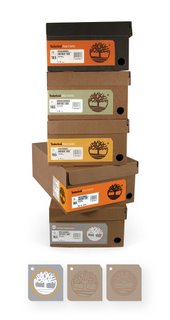
I’m having to do a lot of apologizing this week… sorry I missed you last night. A social event ran a bit longer than expected, and afterwards… well, the picture for Monday’s post was even more appropriate.
The folks at Timberland are taking a step forward (get it — shoe makers… taking a step forward… aw, never mind…) towards greater transparency by placing information about the shoe’s figurative footprint right on the box. The “Our Footprint” label includes three sections:
- “Environmental Impact” reports the average number of kWh kilowatt-hours that are used to produce a pair of Timberland shoes and the percentage of renewable energy Timberland uses from sources such as the sun, wind and water. Total energy use (measured in kWh and obtained from each factory’s utility bills) is divided by footwear production. Each factory gets assigned a weight according to the percent production they do for Timberland. The weighted factory scores are then averaged to produce an average kWh (or energy use) per pair.
- “Community Impact” details the percentage of factories assessed by Timberland against its Code of Conduct, the percentage of child laborers in factories’ workforce and the total number of hours Timberland employees volunteered in the previous year.
- “Manufactured” tells in what factory and what country the product was made.
The “nutrition label” will be placed on greener boxes made from 100% post-consumer recycled fiber with soy-based inks and water-based solvents. The company’s not stopping there, though. They plan to adopt the “Our Footprint” label for apparel, and are also developing a Green Index (which they compare to an Energy Star rating) for measuring their shoes’ environmental impact in terms of climate, chemical use and material use.
Since the apparel industry generally does carry a heavy environmental footprint, this is a bold move by Timberland: they’re not just saying “We’re green(er),” but giving consumers the numbers by which they can judge that statement. Will many individuals go out of their way to verify the labels? Probably not. Timberland can count on organizations like Greenpeace to check up on them, though, so I’d guess this is a genuine show of transparency rather than an attempt to greenwash.
Categories: timberland, shoes, footprint, environment, recycled, labeling, business, apparel, us


tom
good shoes
tom
ugg lovely sunburst tall chestnut boots
Hungery ants
Timberalnd is a long-history brand,pride of America. It was founded 1918 in Boston.